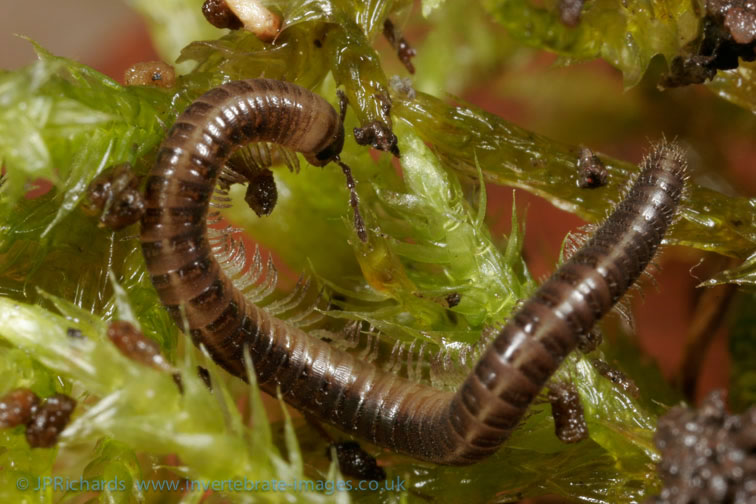Leptoiulus belgicus (Latzel, 1844)
Status:
- GB IUCN status: Least Concern
- GB rarity status: Nationally Scarce
ID Difficulty
Identification
This is a large millipede, typically dark above with contrasting lower flanks (though colour may be variable) and a elongated pointed projecting telson (tail). It is usually readily identified by the characteristic thin yellowish line running along the centre of the body. However, this is not always apparent and to avoid confusion with other similar species, such as Leptoiulus kervillei, Ophyiulus pilosus or Julus scandinavius, identification is best undertaken by examination of a male specimen.
Distribution
In Britain this species is most frequent in south west England and south Wales but there were isolated records from Eigg, Kent, Norfolk and north Wales Lee (2006). Surprisingly it has not been recorded from the south west of Ireland; the few Irish records are all from the northern coasts. BMIG Field Meetings held in western Scotland have discovered several addition sites (Barber & Gregory, 2008; Gregory, 2016) and it may prove to be under-recorded along the entire western coast of Britain. It is expanding its range inland, and since 2010 has been recorded from Yorkshire, Derbyshire, Hampshire and Oxfordshire (Newsletter 40, pg 7) and also Nottinghamshire and Leicestershire.
This species has an extended Atlantic distribution suggesting it ought to be more widespread in southern England. It is found throughout western Europe as far east as Germany and the western tip of Austria but reaches its northern limit in Belgium (Kime, 1999).
Habitat
It has been collected from a wide range of habitats and analysis of the recording scheme data suggests it has no particular preferences although Morgan (1988) linked it with synanthropic habitats in south west Wales. Kime (2004) listed a wide range of habitats for L. belgicus in Belgium but associated it with warm positions on light, well drained soils. The habitat analysis provides no evidence of a preference for particular soil types but it does suggest a strong association with coastal sites and this is probably due to the warmer microclimates in these areas. Notes on the ecology of this species are also given in Alexander & Lee (2014).
Phenology
Animals are active throughout the year but show a pronounced peak in activity in late summer and autumn when they mature (Kime, 1999; Morgan, 1988; Pedroli-Christen, 1993). It is likely that the life history is similar to that of Julus scandinavius (Blower, 1985). Thus breeding would occur in the spring. Both sexes then die so few adults should be expected during the summer months.
This updated species account is based on Lee (2006).
Links
MilliBase - Global catalogue of Millipedes: https://millibase.org/aphia.php?p=taxdetails&id=394569








